Observe in Order to Memorise
We see, but we do not always notice.
Every day a whole cascade of images passes in front of our eyes. How many are caught in the net of our sight? Very few. Why? Because we have not taken the time to observe them. However – and it is the same in all fields – time does not like us to ignore it.
We regularly take the same route but are still not able to describe it in any great detail. More often than not the changes that take place around us escape our sense of observation. They pass unnoticed even though we have seen them.
Can you, for example, describe the decor in your local bakery shop? How many times have you ‘discovered’ or ‘seen’ for the first time a trinket, a painting or whatever object that has been sitting there under your very eyes for months? Have you never asked a friend if he has just repainted his living room when he has done nothing to it, even though you frequendy call in? Until this particular day you have never really opened your eyes to notice the colour of the walls.
- Observing is allowing your look to take its time, to notice details and to go in search of precision.
- Observing is getting your sight to contribute to a rediscovery of the world that makes up your environment. Life in the fast lane, stress, the habit of always going that bit quicker, all constitute barriers to observation, and lead us to neglect an important mass of information which becomes permanendy buried in the unconscious, in the store of images that are never revived.
- Observing is a litde like learning how to live again, rediscovering the shapes, colours and objects that make up our universe.
- Observing is exchanging a passive gaze, which is quite enough for the average television viewer, for an active gaze, which is not content with just seeing.
- Observing is developing our memory.
In this chapter, different tests highlight the value of observation and the role it plays in our memory. In particular they involve the capacity to retain information accepted into the visual memory.
Through these tests, which have deliberately not always been quantified, you will develop in particular your power of observation and your visual memory.
DISCOVERING THE FAMILIAR WORLD
We tend in some way to lose contact with objects that are all around us. Without going as far as forgetting them, we very often have an image of them that is more blurred than we imagine.
This test is aimed at making you rediscover the world around you. You have two minutes to answer the questions.
Bearing in mind the purely subjective nature of this first task, there is no scoring.
A room in the house
You go into your kitchen every day, but are you able to recall its details precisely?
- Describe the way in which it is laid out.
- Describe the objects which are in it, in the order in which they are arranged.
Books
Are you able to locate a particular book on the correct shelf without any hesitation? Reply immediately to the following questions:
- Where is the dictionary?
- Describe its cover without looking at it.
- Roughly how many books do you have?
Music
You almost certainly have a collection of records, compact discs or cassettes. Select a tide at random.
- Describe, without looking at it, the illustration that appears on the cover or front of the packaging.
- Detail the following:
- the colours
- the shape of the lettering
- the design of the picture.
The car
When you reply to the following three questions, take the car that you use or are driven in most often.
- Describe precisely the dashboard of the car.
- How many sign symbols are there?
- Specify them.
At work
If you work in a business:
- Try to make a plan of the site or building.
- How many offices are there?
- What colour are the doors?
- What colour are the walls?
If you are a student or pupil, answer the same questions but substitute class rooms for offices.
Photos and illustrations
Picture in your mind a photo that you have – preferably one in which there are several people. Then take a piece of paper and describe on it what is represented in the photo, trying not to leave out any detail.
The people
- Begin by writing down the number of people in the photo.
- Spend time detailing what each is wearing.
- Describe their relative positions (who is sitting down, who is standing up, etc).
- Describe their faces: expression, hairstyle, glasses (if any)
- What are they wearing on their heads: scarf? hat?
The background
- Is it outside? In which case, describe the natural surroundings (garden, beach, mountain, etc).
- Is it indoors? In which case, detail: the furniture, the decor (wallpaper, carpet, chair covers, etc). the objects in the room
Repeat this exercise using an illustration or an image from a piece of publicity, for example.
Always remember to check what you have said against the original photo afterwards. This will enable you to measure accurately your power of observation.
Compare ...
Each time you do a test like this, verify it afterwards by comparing what you have written down on your piece of paper with the reality. Check it against the original photo, illustration or advertisement.
... and note
- Everything you have forgotten.
- All the details that have escaped your visual memory.
- Be as accurate as possible in order to make progress. Above all, do not cheat. This way you will develop your powers of observation at the same time as your memory.
ON THE DOORSTEP
There would appear to be nothing easier than memorising a stylised house. Nevertheless, one is aware that it is not enough just to see in order to reconstitute the information as accurately as possible. Again, it is necessary to look and register in order to put one’s faculties of observation to work. Sometimes one has to make an extra effort to ensure certain images are planted in one’s brain.
There is absolutely no trap in this test. First, you have to look at the drawing of the house below for 15 seconds. Then go through the questions that follow and the advice given about this test, without looking again at the drawing.
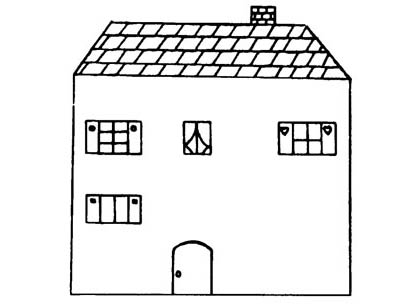
Questions
- How many windows did you see?
- How many shutters have hearts?
- How many windows have curtains?
- How many rows of tiles are there on the roof?
- How many window-panes have you spotted?
- How many rows of bricks are there on the chimney?
- How many windows are there on the first floor?
- How many windows have shutters?
- How many different motifs decorate the shutters?
- How many rounded shapes have you noticed?
Read through these questions very carefully. Beside each of the questions, write the number you think is correct.
You have two minutes to answer the questions. Score two points for each correct answer.
We have said ‘observe’
To observe, from the Latin observare, means to make one’s behaviour conform with that prescribed by the law, but also to consider with application or examine, regard in an attentive way, notice ... So, if to observe is to regard with attention, to regard with attention is to start to understand. And to start to understand is to learn to reformulate, which is to train oneself to remember. One can therefore say that to observe is to practise a language for laying down the foundations for a certain form of memory.
YOUR ANSWERS
1. Number of windows
2. Number of shutters with hearts
3. Number of windows with curtains
4. Number of rows of tiles
5. Number of window panes
6. Number of rows of chimney bricks
7. Number of first-floor windows
8. Number of windows with shutters
9. Number of different motifs on the shutters
10. Number of rounded shapes
Answers for evaluation
|
1 |
4 |
6 |
3 |
|
|
2 |
2 |
7 |
3 |
|
|
3 |
1 |
8 |
3 |
|
|
4 |
4 |
9 |
3 |
|
|
5 |
14 |
10 |
8 |
Answer analysis
- One is conscious, even having been warned, of the difficulty of memorising what one thought one had looked at.
- Different strategies were possible. On the one hand, a photographic image of the whole which could be reconstituted by our visual memory. On the other hand, rigorous and systematic observation of all the elements contained in this very schematic house, using some logical and progressive principle of one’s choice. Example: one could start by the front door and move on to look at the ground-floor window (panes, shutters and motifs), then spend time observing all the elements of the first floor, before finishing with the roof and chimney.
- In Question 10, the central window on the first floor includes two rounded shapes and not four, since one must take into account the whole of each curtain.
Remember
To memorise what you have observed:
- Work towards a photographic image of the whole.
- Work towards a systematic observation of all of the elements, following a logical progression.
TIME FOR OBSERVATION
This is not a test in the proper sense of the word. You are being asked to look at the drawing below for 15 seconds and then redraw it. For this exercise, you have one minute.
It is not your talent as an artist that matters here, but rather your ability to remember what you have seen.
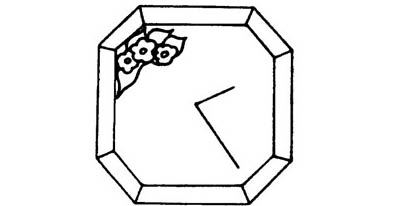 Verification
Verification
Compare your drawing with the original.
Go through what you left out, what you got wrong and what you added and make a note of them:
THE WAITERS’ MEMORY
Some waiters never remember who ordered what. Others, on the other hand, deserve our admiration. They are capable of remembering several different orders, not only from a single table but also throughout the restaurant. They never serve a coffee to someone who asked for a lemonade.
What is their secret? How can one explain their prodigious memory. In fact there are several possible ways in which to achieve the same result.
Some work particularly by association. They take orders to a system and, by observation, associate them immediately with the right customer without confusing which customer asked for what.
Others, using a kind of permanent mental gymnastics, remember particularly well because they concentrate and put all their attention on their work.
Then there are those who simply enjoy the job and whose motivation strengthens the memory.
None of these methods conflict and often they combine in the same waiter. However, in the majority of waiters, just one of these characteristics dominates even though the others may also be present.
MATCHING THE IMAGES
This test relies essentially on the visual memory. Below is a panel with ten boxes. Inside each box there is an image. These boxes have deliberately not been numbered, in order to avoid involving the associative memory. It is therefore simply a matter of retaining what the retina has placed in your brain.
The Ancient Greeks and Romans attached quite a special importance to images. They held the view that sight was superior to the other senses, which is why they used it for memorising their speeches, notably with the method of loci, which we have already discussed at the beginning of the book-Remember that it is impossible to memorises places and images without observation.
You have one minute to look at these ten pictures. Then write down the name of the image that relates to that box, without any further reference to the ten illustrations. Score two points for each correct answer, making a maximum of four points for each correct line.
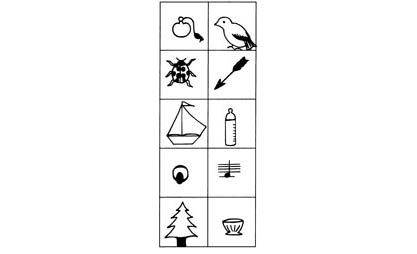
YOUR ANSWERS
Name of picture in each box in correct order
WHAT DO WE REMEMBER BEST AND WHEN?
- We remember best what we like.
- We remember best what interests us.
- We remember best if there is emotion (a strong sensation of intense pleasure or deep pain – all emotional shocks leave their mark on the brain).
- We remember best if we are motivated.
- We remember best when we pay attention.
- We remember best when we have understood properly.
- We remember best when we concentrate.
- We remember best what we put in order in our memory.
Answer analysis
- You will obviously have compared your answers with the original panel of pictures in order to mark up your score. Perhaps you will have noticed some mistakes or omissions. Perhaps you will have answered correcdy throughout.
- To memorise this type of picture panel correcdy, it is not a question of working on type associations (such as animals – bird and ladybird – for example). On the contrary, you have to rely on your sight, which must print in the brain not only the picture but at the same time its position.
Remember
To have a faithful visual memory:
- Observe and do not be content just to see what you must retain.
- Assimilate the image and the place simultaneously.
- Reply quickly, since this type of exercise relies on the immediate memory.
OBSERVATION MUST NOT DECEIVE
This is not so much a test as an exercise in observation – and more difficult than the previous one. There are eight more pictures to memorise. The object is to remember them in the order in which they are presented.
You have one minute to look at the drawings. Then write in the name of each object in its correct order.
THE DANGER OF MAKING ASSERTIONS
The inaccurate reporting of a fact, supposedly accurately observed, has often been the source of conflict, of misunderstanding or, even more serious, of unintentionally supplying false evidence, in all good faith.
To make an assertion about something one has been able to observe always presents an element of risk. Exercises of the kind we are giving you in this book, which do not put anyone’s destiny in danger, demonstrate quite clearly the fragility of the visual memory while, at the same time, helping to develop it.
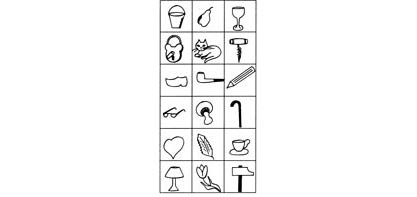
YOUR ANSWERS
Write the names of all the images in the panel you have just looked at.
Remember
To observe without risking any mistakes:
- Memorise each picture and its position simultaneously.
- Do not assume too quickly that what you think you recall really is the case.
OBSERVATION AND MEMORY
In current language, ‘to make an observation’ to someone means ‘to make a remark’ – that is to say, ‘to mark again’. This expression is not without significance, since to know how to observe implies that one knows how to remember and also recall.
Observation occurs because we want to ‘mark’ a fact, an expression or whatever, in our mind, firmly and permanently. But the very certainty of a precise observation runs the risk of leading to a distorted recollection which does not tally with the reality. It is the open door to unintentional false evidence, to misunderstandings, and to confusion.
So, one must learn to ‘lock in’ one’s observation in order to check the original information already fixed in one’s brain. For that, one simply has to shut one’s eyes for a few seconds, empty one’s mind and then look again to make sure that the original image and the checked image are identical. Under these conditions, observation supplies the memory with reliable material.
Answer analysis
There is no scoring in this exercise. It is simply intended to reinforce the previous test, which you have already marked.
- Out of the 18 pictures you had to memorise and place in their correct boxes:
- If you have less than ten correct answers, you need to work on your visual memory.
- If you have 10-13 correct answers, your visual memory is satisfactory, but you must work at developing it.
- If you have 14-16 correct answers, your visual memory is very good, but you should still exercise it so that it is even better.
- If you have 17-18 correct answers, congratulations! You have an excellent visual memory. Look after it!
A MEMORY FOR NUMBERS
To develop your power of observation, you need to exercise it on different things.
The panel below contains ten boxes, inside each of which there is a different number. Although the numbers can be considered like the pictures, you do not in fact use the same method for memorising them. If you look at 37 and 26, for example, you could quite easily reproduce them incorrec-dy as 27 and 36. On the other hand, you could not muddle up a cat with a ladle or a flute with a broom.
To achieve a good score in this test, you are advised not to try and find any meanings or associations but to absorb the numbers in their entirety with a good, hard look. This is the key to observation. You do not have sufficient time to find a mnemonic method and store the information in a drawer of your long-term or even medium-term memory.
You have only one minute to look at the numbers, before reproducing them – in their correct positions.
Score two points for each correct answer, making a maximum score of four points for each correct row.
|
32 |
11 |
|
4 |
28 |
|
25 |
9 |
|
18 |
14 |
|
17 |
58 |
Answer analysis
- Numbers are more difficult to remember than objects because we do not think of them as images.
- If, in your daily life, you want to develop this sense of observation, practise remembering, for example, the prices of articles displayed in a shop-window (and not just those that interest you) or the local bus timetable (if it is not too long!).
Remember
To retain a panel of numbers through observation:
- Think of them as images.
- Absorb them as an entirety.
WHEN GEOMETRY PLAYS ITS PART
This drawing is a geometric abstract. Look at it for one minute, cover it up, and then reproduce it in the empty space opposite. This is an exercise and not a test.
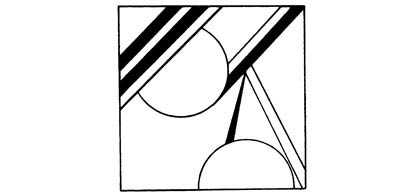
Compare your drawing with the original.
Answer analysis
- An abstract design is a lot more difficult to remember than a realistic drawing, especially when it is very detailed.
- Do not worry about your ability as a draughtsman. The point of this exercise is to evaluate your ability to remember shapes and their position in a given area.
Remember
To memorise an abstract geometric design:
- Force yourself to take a fresh look when observing an unusual geometric drawing which has no reference in your traditional cultural code.
- A fresh look presupposes a memory that is ready to accept non-stereotypical information.
A CLUSTER OF STARS
This test relies on your ability to remember the position of figures in a given space. The panel below contains ten boxes. Inside each there are four stars. You have to reproduce the exact position of these stars in their corresponding boxes in the answer panel that follows.
There is no point of reference in any of the boxes. So you have to ‘photograph’ the different positions of the stars contained in the boxes before completing this test.
Imagine what a map of the night sky could offer! Here, at least the stars are not revolving. They are fixed inside each box.
You have one minute to look at the ten boxes. Score two points for every perfectly correct answer (approximations do not count). The maximum score for each row of correct answers is four points.
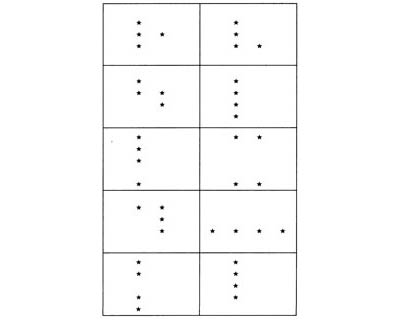
Compare your positions with the original panel.
Answer analysis
- Approximations have been dismissed as unacceptable since they reveal a flaw in your method of memorising the positions of elements in a given space.
- The systematic positioning of four elements in identical square spaces makes visual memory easier.
- What you needed to register was the sideways movement of the stars’ positions.
Remember
To help the visual memory with changing positions in open spaces:
- Photograph the position of the elements.
- Note the type of position change they undergo.
GEOMETRIC SYMPHONY
This exercise presents a few difficulties.
The panel you have to look at contains 18 geometric designs, each of which occupies a specific place. If it was a panel of traffic signals, for example, this visual memory exercise would offer no particular problem because it would represent symbols that were coded, universally known and familiar.
Here there is no logic behind the collection of designs which have absolutely nothing in common with each other. So your memory has to rely solely on observation to reproduce the contents of the panel in the correct order.
The aim of this exercise is to develop your visual memory.
Having looked at the designs for two minutes, you have to reproduce them.
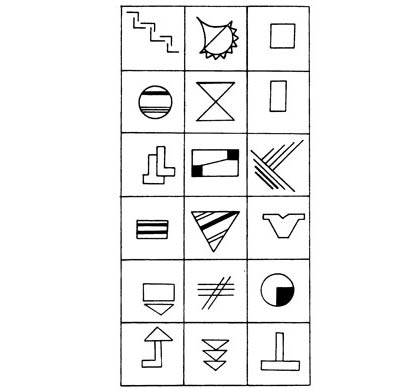
Compare your drawings with the original panel.
Answer analysis
- This exercise reinforces the one entided ‘When geometry plays its part’. However, the number of designs to remember is increased from one to 18. Each design required very special observation.
- The difficulty with this exercise rests in memorising shapes, most of which have no reference in our cultural code. On the whole, they do not resemble any object in everyday life. This is therefore a purely visual exercise which requires one’s immediate memory to store numerous elements and details, rather than a coherent design.
Remember
To memorise geometric designs:
- Do not neglect to observe details.
- Develop a memory for shapes.
KIM’S GAME
This is a very well-known game.
You have a panel containing 35 drawings. You are not going to be asked to write down the names of all the objects you have seen in the equivalent blank panel and still less to reproduce them! However, the questions you have to answer will certainly not be what you are expecting.
Look at the panel for two minutes. You will then have to answer 20 questions. Some of them simply require a yes or no, while others will need a number.
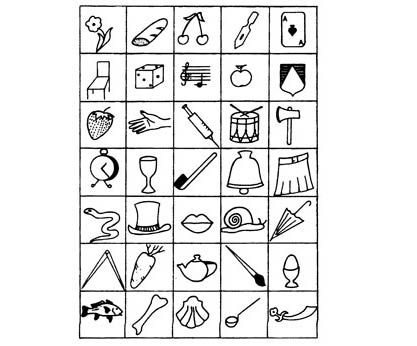
Questions
1. Number of animals
2. The fingers of the hand are spread apart
3. There are three different fruits
4. Number of visible dots on the dice
5. Number of items of furniture
6. The shield is above the playing card
7. The playing card is the ace of clubs
8. Number of flowers
9. Number of cutting objects
10. The alarm clock reads 1.25
11. The bread has been cut
12. Number of musical instruments
13. There is nothing edible in the middle column
14. There are two vegetables
15. The teapot has a lid
16. Number of horizontal rows
17. Number of leaves on the apple stalk
18. The skirt has a design on it
19. The lips are closed
20. There is only one paint-brush
THE ORIGIN OF KIM’S GAME
What we know as ‘Kim’s Game’ comes from the novel Kim (1901) written by Rudyard Kipling. Kim O’Hara, orphan of an Irish sergeant in the Indian Army, is a child of Lahore, capital of Tendjad. He becomes a pupil of a Tibetan lama, whom he follows across India. He carries important messages for the British secret service and eventually one Colonel Creighton decides to make him a secret agent.
Kim undergoes intensive training with the aim of developing his memory. In no time at all he is capable of naming 20 precious stones that are shown to him, as well as giving all their different peculiarities.
It was by practising a similar exercise, but looking quickly at objects placed in a shop-window and trying afterwards to describe them in detail, that the great conjurer Robert Houdin acquired his prestigious memory.
Kim’s Game, which has a number of variations, is played by adults and children alike and is also used in psychology. Different objects are placed on the ground or on a table. The players look at them for a few moments, after which the objects are removed and everyone has to make a list of what was there.
Comment
When one is looking instead of seeing, one very often does not know what it will be useful to observe. Those who have used their visual memory for this test, will perhaps have remembered the majority of the drawings in the panel and their positions. But they were not able to guess the nature of the questions that were going to be asked.
For this reason, one must observe in an open minded way, that is to say from a wide angle, and not for the purpose of a presupposed answer to an anticipated question.
Answers for evaluation
|
1. |
3 |
11. |
Yes |
|
2. |
Yes |
12. |
1 |
|
3. |
Yes |
13. |
No |
|
4. |
6 |
14. |
No |
|
5. |
1 |
15. |
Yes |
|
6. |
No |
16. |
7 |
|
7. |
No |
17. |
1 |
|
8. |
1 |
18. |
No |
|
9. |
2 |
19. |
Yes |
|
10. |
Yes |
20. |
Yes |
Answer analysis
- 3 animals: snake, fish and snail.
- Yes, the fingers of the hand are spread apart.
- Yes, strawberry, apple and cherry (there are two but they count as one fruit).
- 6 dots visible on the dice.
- A chair.
- No, the shield is under the playing-card.
- No, the card is the ace of spades.
- 1 flower.
- 2 cutting objects: axe and sabre.
- Yes, the alarm-clock reads 1.25.
- Yes, the bread has been cut.
- 1 musical instrument: drum
- No. There is something edible because the cherries figure in the middle vertical column.
- No. There is only one: a carrot.
- Yes, the teapot has its lid on.
- There are 7 horizontal rows.
- There is 1 leaf on the apple stalk.
- No, the skirt does not have a design on it.
- Yes, the lips are closed.
- Yes, there is only one paint-brush.
Remember
To observe a series of different elements one after the other:
Practise three types of observation at a time:
- The accountant’s regard for scanning and registering all the numerical information, all the quantifiable data, for fixing the management of space and the organisation of the elements well in his memory.
- The painter’s regard for photographing the shapes, the graphic relationships, the harmony or the anachronisms, for seeing certain elements bordering on or overlapping with others.
- The detective’s regard for observing the anomalies, things that are bizarre, but also the tiniest details.
Exercise
Practise Kim’s Game with a variety of objects and set up a competition among a group of people. The comparison between the different results will clearly indicate the differences between the various types of memory.